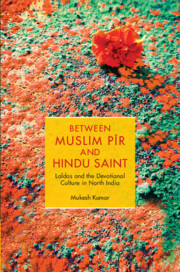Book contents
- Frontmatter
- Dedication
- Contents
- List of Figures, Maps and Tables
- Acknowledgements
- List of Abbreviations
- A Note on Transliteration
- Maps
- 1 The Spectre of Binaries
- 2 Laldas and Religious Duality of Pīr and Sant
- 3 The Laldas Shrines and Inter-religious Disputes
- 4 A Fait Accompli: The Complete Hinduisation of the Laldas Order
- 5 Religious Reform and Shared Shrines
- 6 Concealment and Secrecy: Hidden in Plain Sight
- 7 Poetic Response to Religious Puritanism
- 8 An Ephemeral Line in the Sand
- Appendices
- Glossary
- Bibliography
- Index
2 - Laldas and Religious Duality of Pīr and Sant
Published online by Cambridge University Press: 30 April 2024
- Frontmatter
- Dedication
- Contents
- List of Figures, Maps and Tables
- Acknowledgements
- List of Abbreviations
- A Note on Transliteration
- Maps
- 1 The Spectre of Binaries
- 2 Laldas and Religious Duality of Pīr and Sant
- 3 The Laldas Shrines and Inter-religious Disputes
- 4 A Fait Accompli: The Complete Hinduisation of the Laldas Order
- 5 Religious Reform and Shared Shrines
- 6 Concealment and Secrecy: Hidden in Plain Sight
- 7 Poetic Response to Religious Puritanism
- 8 An Ephemeral Line in the Sand
- Appendices
- Glossary
- Bibliography
- Index
Summary
Folk stories in Mewat narrate how, in the sixteenth century, Sahab Khan, the Mughal governor of Tijara, near the present-day Alwar district in eastern Rajasthan in north India, summoned Laldas (1540–1648 CE) to account for not practising Islam, despite being born into a Muslim family. Sahab Khan offered him meat, saying it was Muslim food that a Muslim should willingly eat. This move was intended to symbolise the saint's Muslim identity and to reintroduce him to the Islamic fold from which he had strayed. The meeting with Sahab Khan is documented in a hagiography—compiled and written in rhyming verses by a Laldas devotee called Dungarisi Sadh:
tabaī mughal ne svāgat karī, baitho pīr dayā tum karī,
rotī-khānā karo kabāb, bhūkhā khāyā badā śabāb,
dān yār to badā ajīj, upar musalmān ki cīj
musalmān hove khāye khulāye, to vah rāh khudā kī pāve. (Dungarisi
n.d.: 26; see Appendix A.1)
Then the Mughal welcomed him saying, sit pīr and bestow your blessings on me
Eat a meal of bread and kebab, it is really tasty when you are hungry
Serving you is a matter of immense joy, this is also a Muslim practice
If a Muslim eats it himself and feeds others, then he attains the path of God.
Although the Mughal officer's invitation for Laldas to consume kebab might seem like a respectful act, it was, in fact, a deliberate tactic aimed to ascertain the saint's religious standing. By depicting Laldas's religious conduct as transgressing Islamic boundaries in these hagiographic narratives, the text seeks to establish his identity as a Hindu saint. According to the verses, Sahab Khan heard reports that Laldas did not pray as a Muslim: he neither performed ablution nor invoked the name of the Prophet, despite being a member of the Meo Muslim caste and the ‘Islam’ religion. In another set of stanzas, Dungarisi Sadh goes on to narrate the doctrine taught by the saint to both Hindus and Muslims, which got him in trouble:
śīlvant santan sukhdāī, satjug kī sī rāh calāī
daurī khabar tijāre gayī, sahib khan sū jā kahī
jāt meo arū musalmān, hindū rāh calāī ān
rojā bang nivāj nā pathe, īd-bakrīd kū man nahī dhare
rojā rakhe nā kalmā kahe, hindū turak sū nyārā rahe
nabī-rasūl kahe nā kahāve, rām-rām mukh setī gāve
- Type
- Chapter
- Information
- Between Muslim Pīr and Hindu SaintLaldas and the Devotional Culture in North India, pp. 39 - 74Publisher: Cambridge University PressPrint publication year: 2024
- Creative Commons
- This content is Open Access and distributed under the terms of the Creative Commons Attribution licence CC-BY-NC 4.0 https://creativecommons.org/cclicenses/

